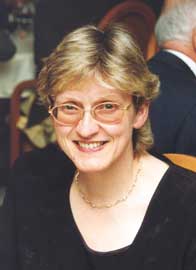 Programme director Christine Dickinson says the MOptom course sets Manchester apart from other optometry departments. 'The MOptom course was introduced 10 years ago and offers a unique experience for a select few students as we can teach them much more than we are able to teach a conventional undergraduate student,' she says. 'The school is also part of a university which plans to be one of the top 25 research centres in the world by 2015.'
Programme director Christine Dickinson says the MOptom course sets Manchester apart from other optometry departments. 'The MOptom course was introduced 10 years ago and offers a unique experience for a select few students as we can teach them much more than we are able to teach a conventional undergraduate student,' she says. 'The school is also part of a university which plans to be one of the top 25 research centres in the world by 2015.'
Manchester's optometry school accepts 70 students with minimum A-level grades A in biology plus another science subject and B in a science or non-science subject. Around 15 mature students are admitted and the school provides full practical support and advice for students with disabilities.
Dickinson is part of a 15-strong academic team including Professor David Henson, research group leader of Eye and Vision Sciences, as well as 13 other staff - 11 of whom are clinically trained. Teaching facilities are due to be moved to an undisclosed, refurbished building in the coming year located closer to the rest of the faculty and Manchester Royal Eye Hospital.
'We would expect to be fully operational in the new location by the start of the 2008-09 academic year at the latest,' Dickinson says.
The BSc and MOptom courses are combined until the end of year two when just four students are selected to do the MOptom for a further two years.
Dickinson explains that the BSc is very similar to the standard optometry courses offered at other establishments. Subjects covered in the first year include anatomy, physiology, dispensing, optometric examination, visual neurophysiology, physical and geometrical optics and maths.
'Students carry out optometric examinations on each other from the first week, moving to volunteer patients by the end of the year. From the end of the second and into the third year they work with patients in our clinic, The Vision Centre.'
During the second year, students are taught about visual optics, visual ergonomics, lamps and lighting, pharmacology, instrumentation, binocular vision, contact lenses, visual neurophysiology and psychophysics, mathematical methods, ocular disease and general medical science.
Between the second and third year, all students spend a week at the Manchester Royal Eye Hospital.
Referral schemes
The programme includes visits to all departments within the hospital, including tutorial presentations. Students are taught about current referral schemes for conditions such as glaucoma and they experience such schemes at the hospital where patients with diabetes are referred to The Vision Centre at the university.
After the week, students return to the school and give presentations on selected patients seen during their placement.
Final (third) year includes clinical practical sessions in optometric examination, further investigative techniques, binocular vision, contact lenses, low vision, dispensing and tutorials on case records. Further lectures cover ocular and systemic disease and legal and professional studies take place and students can either carry out an experimental project or take two option courses from a wide range of topics such as 'Leadership in action' and 'Religion, medicine and science'.
Four students selected for the MOptom course - 'based on their academic performance in exams and clinical work and after an interview process' - start a six-month pre-reg period with a hospital during the second semester of year three. They then follow a second six-month pre-reg in private practice and return to university for additional studies and to complete a project. If successful in their examinations they are admitted to the GOC register without entering a pre-registration year.
'We sort out the students' placements for them which are considered to be a very high quality experience. Unlike the other students they have the advantage of six months in a hospital environment and another in an optometric practice,' she says.
Dickinson adds that the course is constantly evolving to reflect the changing emphasis of optometric practice. However, 'despite changes in working patterns and optometrists' scope of practice' and the high number of applicants (typically between 900-1,100), she doesn't think the number of places should be increased.
'It would not be an advantage to the profession to graduate considerably more students each year than there are members leaving the profession.'
Elsewhere on the course, an active student-run society organises formal and informal activities.
For students on the BSc Hons course interested to arrange their pre-reg year, the Optics Society invites representatives from multiples, hospitals and the Association of Optometrists to talk about working for independents.
'Society representatives act as ambassadors for the university and help out when prospective students visit,' explains Dickinson.
But it isn't all about hard work at Manchester University. The society is also responsible for ensuring students enjoy themselves and each year they organise a number of social events including the popular 'Eye Ball'.
To find out more visit: www.manchester.ac.uk
